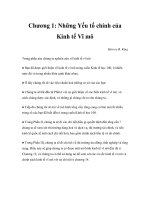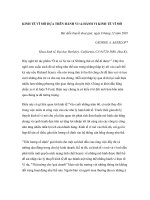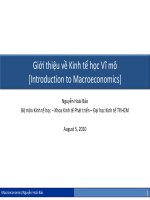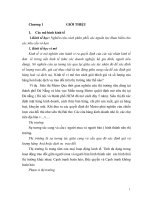KINH TẾ VI MÔ Chapter 1 microeconomics 2015
Bạn đang xem bản rút gọn của tài liệu. Xem và tải ngay bản đầy đủ của tài liệu tại đây (618.6 KB, 10 trang )
FTU- MICROECONOMICS
Contents
1.
2.
3.
Basic Concepts
Economy and Three basic questions
The optimum economic choices
Chapter 1: Basic Concepts in Economics
and Microeconomics
Basic Microeconomics
For Undergraduates
1
KieuMinh-FTU
2
KieuMinh-FTU
Resources
1.
2.
3.
1.1.Basic Concepts
4.
Land: Nature resources
Labor (L):
Capital: Physical capital (K)
Entrepreneurship
Limited nature of society’s resources.
•Economy
•Resources
Resources are scarce.
•Individuals
3
KieuMinh-FTU
4
KieuMinh-FTU
1
FTU- MICROECONOMICS
Scarcity
Scarcity means that society has limited resources and
therefore cannot produce all the goods and services
people wish to have.
Limited
Resources
Unlimited
Wants
5
KieuMinh-FTU
Economy
6
KieuMinh-FTU
Individuals
“oikonomos” (Greek): “One who manages
a household”
Household - many decisions of allocate
Household = Consumers
Firms = Producers
Government
limited resources
Ability, effort, desire
Society - many decisions
Allocate
Allocate
7
resources
outputs (goods and services)
KieuMinh-FTU
8
KieuMinh-FTU
2
FTU- MICROECONOMICS
Our first model: The circular-flow diagram
Visual
model of the economy
how dollars flow through markets
among households and firms
Shows
Decision
makers
Firms & Households
Markets
9
KieuMinh-FTU
For goods and services
For factors of production
10
KieuMinh-FTU
The circular flow
1.2. Economics and
Three Basic Questions of the Economy
•
11
KieuMinh-FTU
12
•
Principles
Microeconomics and Macroeconomics
•
Positive vs Normative Analysis
•
Models
KieuMinh-FTU
3
FTU- MICROECONOMICS
1.2.1 Three Questions of an economy
Scarcity raises three questions, which every economy must answer.
13
KieuMinh-FTU
1.2.2 Economics Definition
What to produce?
How to produce?
For whom?
• Using the economy’s
scarce resources to
produce one good
requires giving
up/sacrificing/trade off
another good. Every
society must decide
what it must produce
with its scarce
resources.
• Society has to make
best decision or
choices in determining
how goods and
services should be
produced.
• If goods or services are
produced, a decision
must be made about
who will get it. A
decision to have one
person or group
receive a good or
services usually means
it will not be available
to someone else.
14
Economics
Economics is to study of how society allocates its scarce
resources for competitive goals (D.Begg)
Economics is to study of how society manage its scarce
resources (G.Mankiw)
Economics is a social science.
Economists try to explain puzzling observations and facts
about the economy.
Economists study:
15
KieuMinh-FTU
KieuMinh-FTU
16
How people make decisions: how much they work, what they
buy, how much they save, and how they invest their savings.
How people interact with one another
Analyze forces and trends that affect the economy as a whole
KieuMinh-FTU
4
FTU- MICROECONOMICS
FOUNDATIONS OF MODERN
ECONOMICS
1.2.3 Microeconomics and
Macroeconomics
CLASSICAL
ADAM SMITH: The Wealth of Nations (1776)
ALFRED MARSHALL: Principles of Economics (1890).
NEOCLASSICAL
During the 1940s - 1950s
Modern classical school of economics.
17
KieuMinh-FTU
Studies how households (or individuals), business (or
firms, enterprises) and the government make decisions,
given scarcity of resources.
Studies the interactions among those market members
and how these interactions have impacts on their
economic benefits and the economy.
focuses on how the markets work.
19
The study of how households and firms make decisions
And how they interact in markets
Macroeconomics
18
The study of economy-wide phenomena, including inflation,
unemployment, and economic growth
KieuMinh-FTU
1.2.4 The scientific method of
economics
Microeconomics
Microeconomics
KieuMinh-FTU
Observation, theory, and more observation
Observation
Theory (Model)
Conducting experiments
More observation
20
KieuMinh-FTU
5
FTU- MICROECONOMICS
Economics model
Economic model
Economic model: an explanation of how the economy or
part of the economy works.
Assumption: Judgements about features that can be
ignored to make the world easier to understand.
Ceteris paribus assumption:All other things being equal. The
term refers to holding all other variables constant when one
variable is changed.
21
KieuMinh-FTU
Come in many forms:
Numerical tables
Graphs
Algebraic equations
Wordy descriptions
22
KieuMinh-FTU
Positive vs. Normative economic
analysis
Positive statements
Attempt to describe the world as it is
Descriptive
Confirm or refute by examining evidence
Answer for “What be”
Normative statements
23
Attempt to prescribe how the world should be
Prescriptive
Answer for “What should be”
KieuMinh-FTU
1.3. The optimum economic choice
24
KieuMinh-FTU
6
FTU- MICROECONOMICS
1.3.1 Why people choice?
People face the fact that resources are scared
People want to maximize their benefit.
25
KieuMinh-FTU
1.3.2 How People Make Decisions
Principle 1: People face trade-offs
Making decisions
Trade off one goal against another
Student – time
Parents – income
Society
27
26
KieuMinh-FTU
KieuMinh-FTU
Opportunity Cost
Principle 2: The cost of something
is what you give up to get it
National defense vs. consumer goods
Clean environment vs. high level of income
Efficiency vs. equality
Households (consumers): maximizing benefit (utility)
Firms (producers): maximizing profit
Government: maximizing social welfare
28
Make decisions
Compare cost with
benefits of
alternatives
Opportunity cost
Whatever most be
given up to obtain
one item
KieuMinh-FTU
7
FTU- MICROECONOMICS
Principle 3: Rational people think at the
margin
Rational people
Incentive: Something that induces a person to act
Systematically & purposefully do the best they can to achieve
their objectives
Small incremental adjustments to a plan of action
Marginal benefits > Marginal costs
29
KieuMinh-FTU
Second model:
The production possibilities frontier-PPF
A graph
Combinations of output that the economy
can possibly produce
Given the available
Factors of production
Production technology
Buyers - consume less
Sellers - produce more
Public policy
Rational decision maker – take action only if
Higher price
Marginal changes
Principle 4: People respond to incentives
Change costs or benefits
Change people’s behavior
30
KieuMinh-FTU
The production possibilities frontier
Quantity of
Computers
Produced
C
F
3,000
A
2,200
2,000
B
Production
Possibilities
Frontier
D
1,000
E
0
31
KieuMinh-FTU
32
300
600 700
The production possibilities
frontier shows the
combinations of output - in
this case, cars and
computers - that the
economy can possibly
produce.
The economy can produce
any combination on or
inside the frontier.
Points outside the frontier
are not feasible given the
economy’s resources.
1,000 Quantity of
Cars
Produced
KieuMinh-FTU
8
FTU- MICROECONOMICS
Second model: The production possibilities
frontier
Bowed out production possibilities frontier
Opportunity cost
Resource specialization
Efficient levels of production
Points on the PPF
Trade-off: The only way to get more of one good
is to get less of the other good
Inefficient levels of production
Points inside PPF
33
KieuMinh-FTU
MATHEMATICS REVISION
A shift in the production possibilities frontier
Quantity of
Computers
Produced
4,000
A technological advance
in the computer industry
enables the economy to
produce more computers
for any given number of
cars. As a result, the
production possibilities
frontier shifts outward. If
the economy moves from
point A to point G, then the
production of both cars and
computers increases.
3,000
G
2,300
2,200
A
0
600 650
1,000 Quantity of
Cars Produced
34
KieuMinh-FTU
Revision (cont.)
Six types of relationship
Increasing
positive
slope
Slope of the curve
Decreasing
Positive
slope
y
28
8
20
1
35
Increasing
negative
slope
2-1
2
Decreasing
negative
slope
Slope= (28-20) = 8
1
x
KieuMinh-FTU
36
KieuMinh-FTU
9
FTU- MICROECONOMICS
Math revision (Cont.)
Facts and impacts
Constant slope
Movement along the curve vs. shift of the curve
Movement along the curve:
When x and y changes.
y
Shift of the curve:
When another variable
other than x and y change.
A third variable shift the
z1
curve.
Constant
positive slope
Constant
negative slope
The line
shifts when
Z changes
Z2
x
37
KieuMinh-FTU
38
KieuMinh-FTU
10









